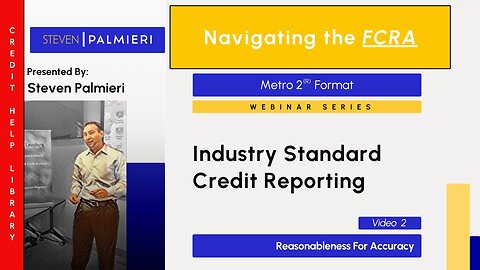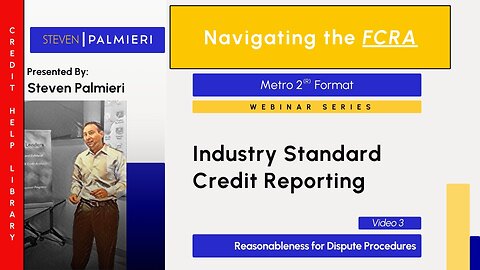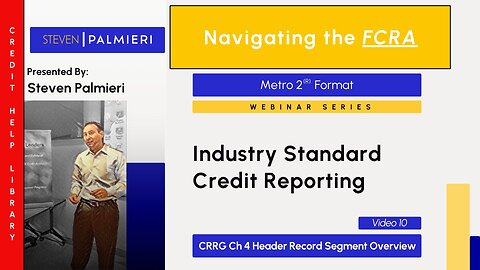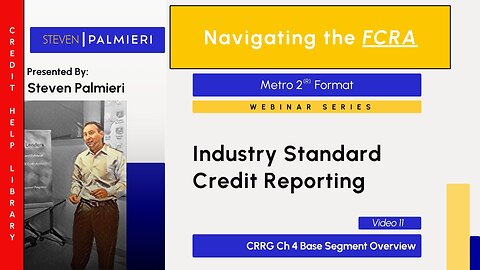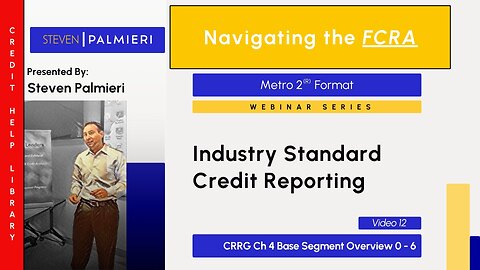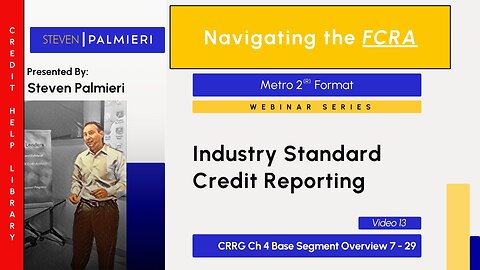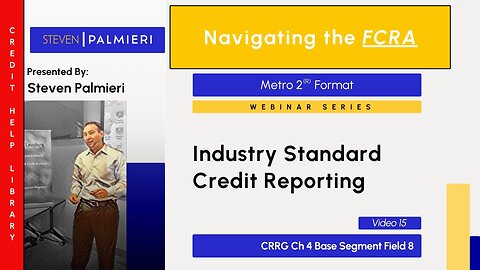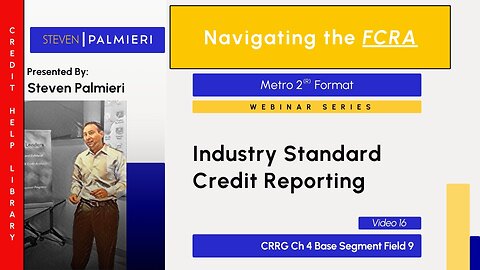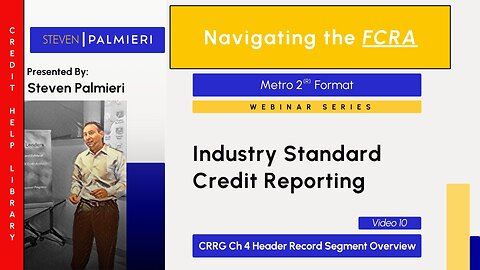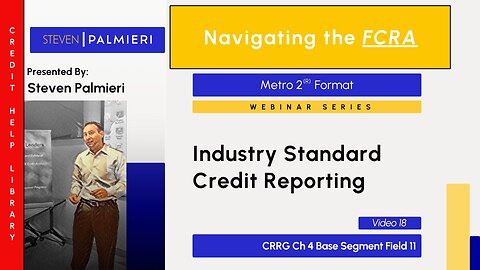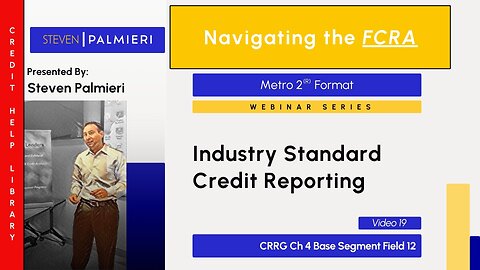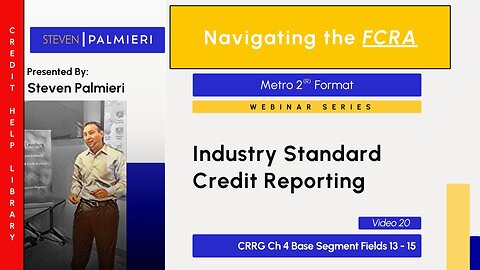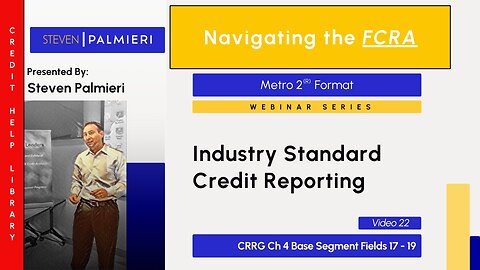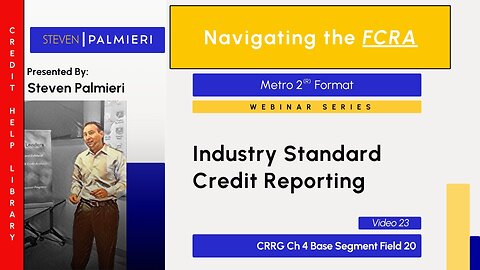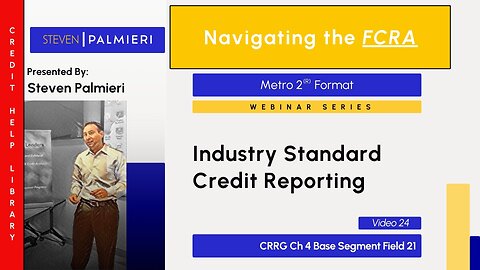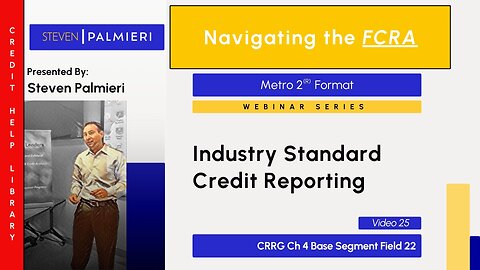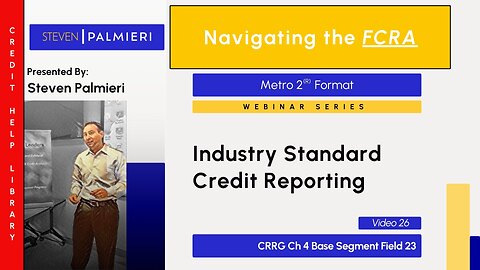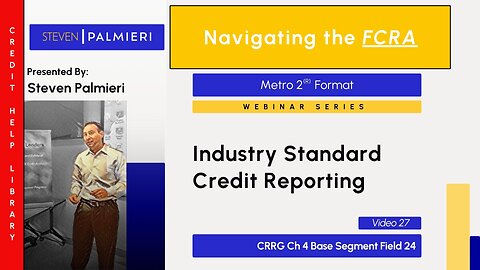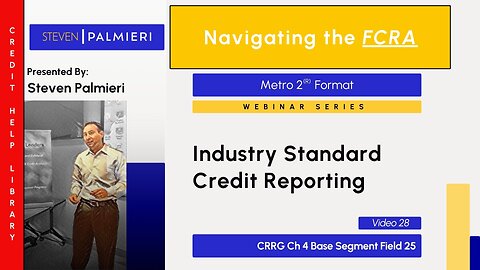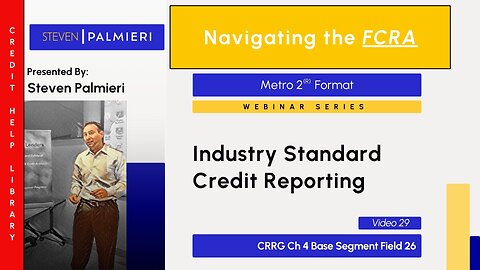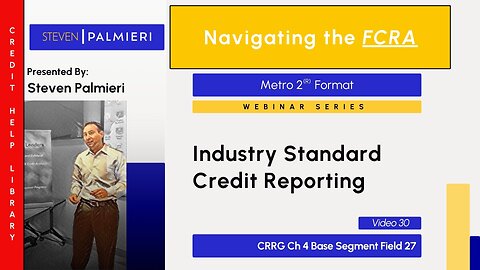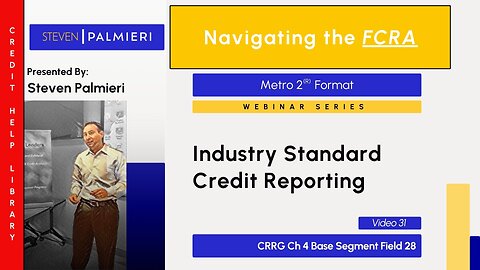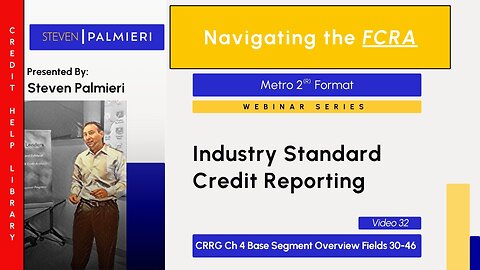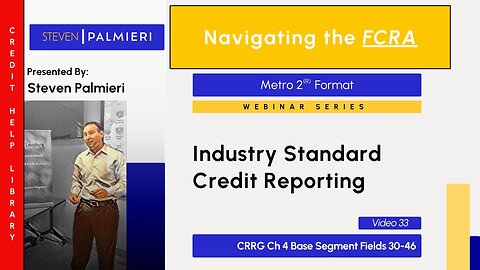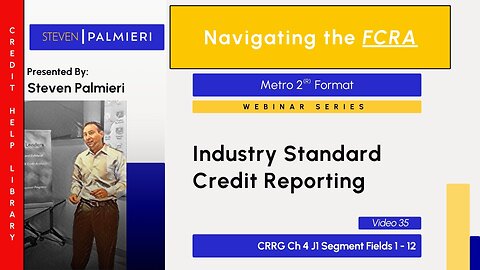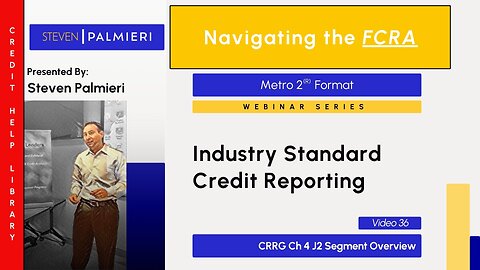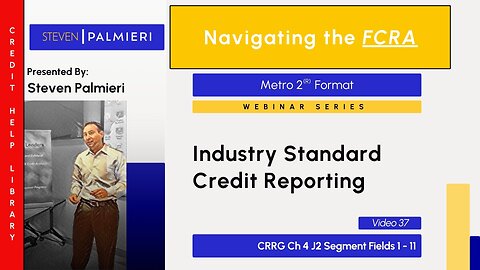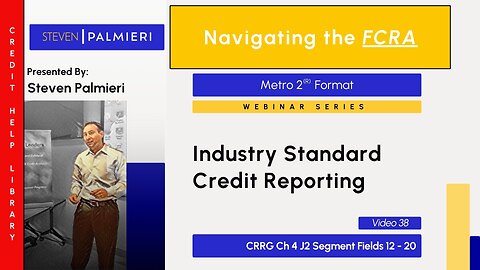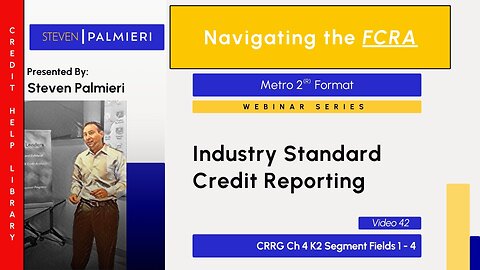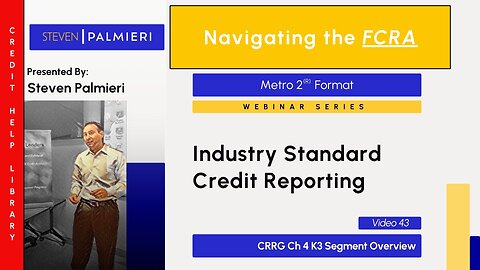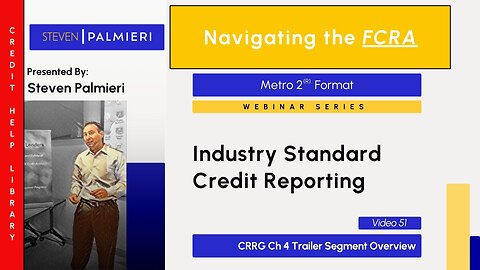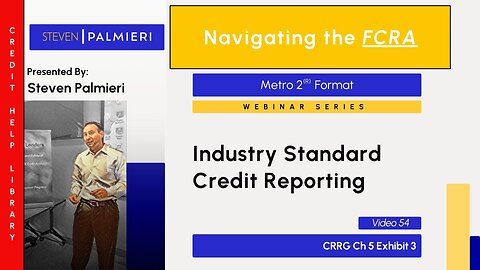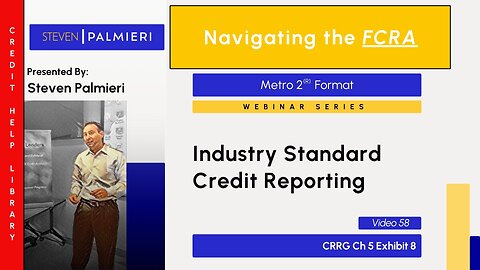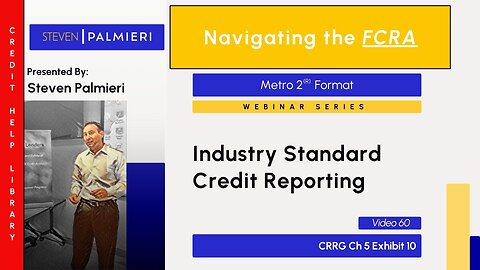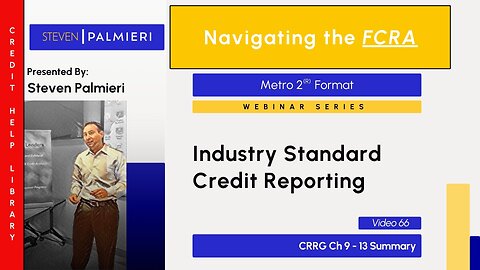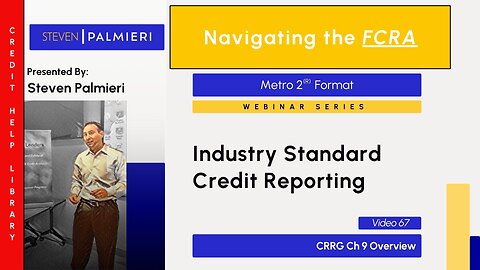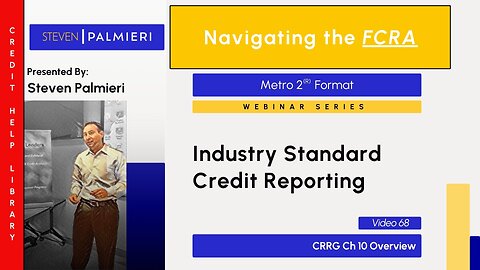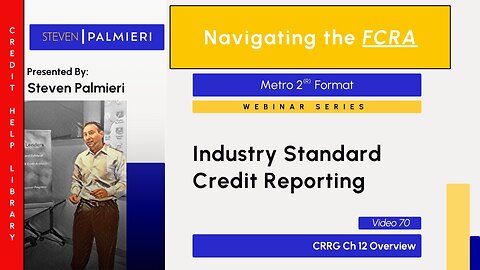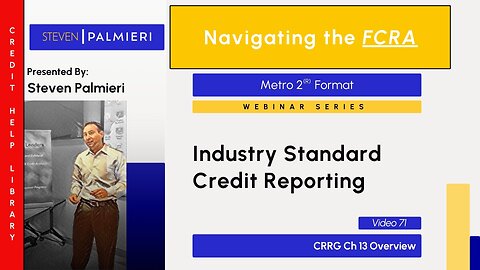Premium Only Content
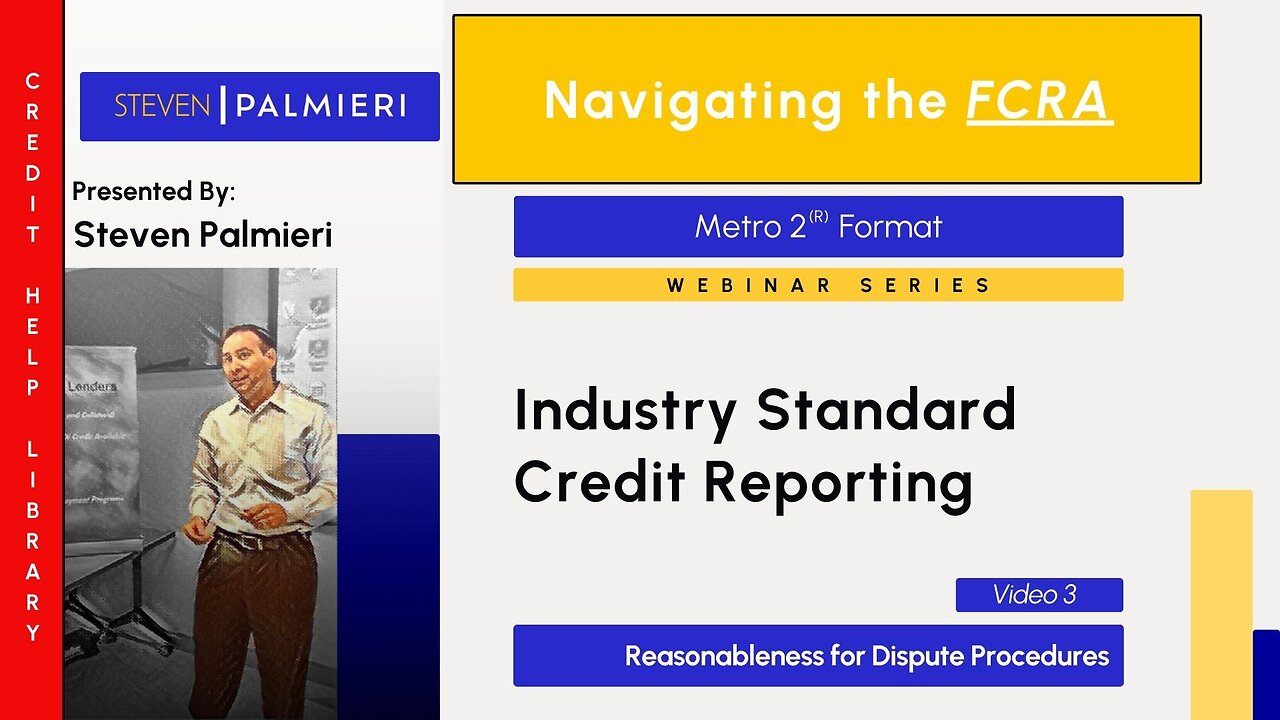
What is an Industry Standard
Reasonableness for Accuracy
Reasonableness for Dispute Procedures
Metro 2 Table of Contents
Ch 1 Overview
Ch 2 Overview
Ch 3 Overview
Ch 4 Overview
Ch 4 Segment Overview
Ch 4 Header Record Segment Overview
Ch 4 Base Segment Overview
Ch 4 Base Segment Overview Fields 0 - 6
Ch 4 Base Segment Overview Fields 7 - 29
Ch 4 Base Segment Field 7
Ch 4 Base Segment Field 8
Ch 4 Base Segment Field 9
Ch 4 Base Segment Field 10
Ch 4 Base Segment Field 11
Ch 4 Base Segment Field 12
Ch 4 Base Segment Fields 13 - 15
Ch 4 Base Segment Field 16
Ch 4 Base Segment Field 16
Ch 4 Base Segment Fields 17 - 19
Ch 4 Base Segment Field 20
Ch 4 Base Segment Field 21
Ch 4 Base Segment Field 22
Ch 4 Base Segment Field 23
Ch 4 Base Segment Field 24
Ch 4 Base Segment Field 25
Ch 4 Base Segment Field 26
Ch 4 Base Segment Field 27
Ch 4 Base Segment Field 28
Ch 4 Base Segment Overview 30 - 46
Ch 4 Base Segment Fields 30 - 46
Ch 4 J1 Segment Overview
Ch 4 J1 Segment Fields 1 - 12
Ch 4 J2 Segment Overview
Ch 4 J2 Segment Fields 1 - 11
Ch 4 J2 Segment Fields 12 - 20
Ch 4 K1 Segment Overview
Ch 4 K1 Segment Fields 1 - 3
Ch 4 K2 Segment Overview
Ch 4 K2 Segment Fields 1 - 4
Ch 4 K3 Segment Overview
Ch 4 K3 Segment Fields 1 - 4
Ch 4 K4 Segment Overview
Ch 4 K4 Segment Fields 1 - 6
Ch 4 L1 Segment Overview
Ch 4 L1 Segment Fields 1 - 5
Ch 4 N1 Segment Overview
Ch 4 N1 Segment Fields 1 - 9
Ch 4 Trailer Segment Overview
Ch 5 Overview
Ch 5 Exhibit 1 - 2
Ch 5 Exhibit 3
Ch 5 Exhibit 4
Ch 5 Exhibit 5
Ch 5 Exhibits 6 - 7
Ch 5 Exhibit 8
Ch 5 Exhibit 9
Ch 5 Exhibit 10
Ch 5 Exhibit 11
Ch 5 Exhibits 12 - 16
Ch 6 Overview
Ch 7 Overview
Ch 8 Overview
Ch 9 - 13 Summary
Ch 9 Overview
Ch 10 Overview
Ch 11 Overview
Ch 12 Overview
Ch 13 Overview
Ch 14 Overview
Reasonableness for Dispute Procedures
The video highlights how the Metro 2 industry standard aids in disputing inaccuracies on credit reports under the Fair Credit Reporting Act (FCRA), focusing on the "reasonableness" requirement for dispute procedures. The FCRA mandates that consumer reporting agencies (CRAs) not only maintain reasonable procedures for maximum possible accuracy (as seen in prior discussions) but also conduct reasonable reinvestigations when consumers dispute information. This is outlined in FCRA Section 1681i, the most commonly used dispute pathway, which requires CRAs to reasonably reinvestigate reported errors. The term "reasonable" appears four times in this section, emphasizing its importance.
Metro 2, as an industry standard created and adopted by the credit bureaus, provides a concrete framework for assessing accuracy and identifying errors in credit reports. When disputing inaccuracies, understanding Metro 2 allows consumers to pinpoint deviations from this standard and clearly notify CRAs of specific errors. The video advises against vague disputes or legal accusations (unless one is legally qualified) and instead recommends using Metro 2 to highlight discrepancies. If the CRA fails to correct or delete the erroneous data after being notified, it becomes easier to argue that their reinvestigation procedures were not reasonable, strengthening a case for noncompliance. This approach simplifies the process of reading credit reports, finding errors, and drafting effective dispute letters to CRAs.
-
 2:07:23
2:07:23
TimcastIRL
7 hours agoTrump SLAMS China With NEW 100% Tariff, Stocks & Crypto TUMBLE | Timcast IRL
280K145 -
 5:15:25
5:15:25
SpartakusLIVE
8 hours agoBF6 LAUNCH DAY || WZ and BF6 followed by PUBG - The PERFECT Combo?
58.1K3 -
 1:33:59
1:33:59
Glenn Greenwald
10 hours agoQ&A with Glenn: Is the Gaza Peace Deal Real? Why was the Nobel Peace Prize Given to Venezuela's Opposition Leader? And More... | SYSTEM UPDATE #529
110K66 -
 1:24:01
1:24:01
Flyover Conservatives
1 day agoURGENT FINANCIAL UPDATE! October 14–31: The Great and Terrible Day Has Arrived - Bo Polny; 5 Mindsets You Must Master - Clay Clark | FOC Show
46.2K4 -
 4:01:36
4:01:36
VapinGamers
6 hours ago $3.04 earnedBattlefield 6 - All Protatoe and Nothing but Net - !rumbot !music
33.4K1 -
 3:23:28
3:23:28
GritsGG
6 hours agoRANK GRIND! Most Wins in WORLD! 3734+!
26K -
 4:13:49
4:13:49
I_Came_With_Fire_Podcast
15 hours agoChina Owning the Mississippi? | Letitia James Indicted, But Don't Get Excited | Insurrection Inbound
32K9 -
 6:20:54
6:20:54
Eternal_Spartan
14 hours ago🟢 Eternal Spartan Plays Battlefield 6! | USMC Vet
19.5K2 -

This is the Ray Gaming
6 hours ago $2.39 earnedBattlefield 6 Launch Day Part 2 | Rumble Premium Creator
23.7K3 -
 58:29
58:29
NAG Podcast
8 hours agoChrissie Mayr: BOLDTALK W/Angela Belcamino
30.1K5

